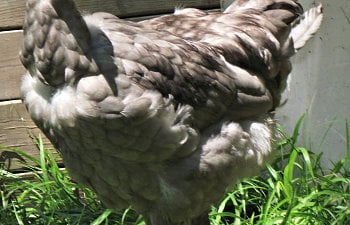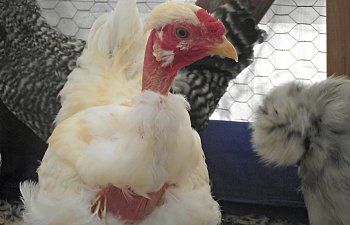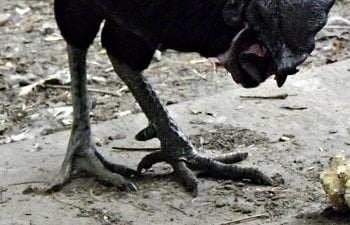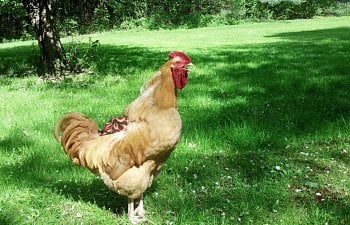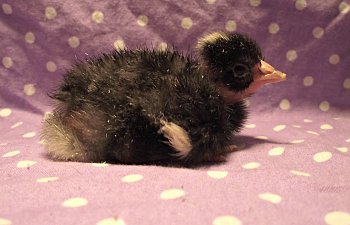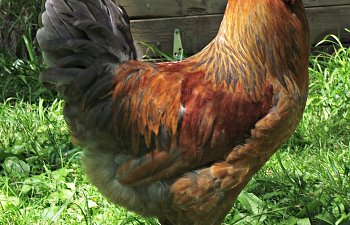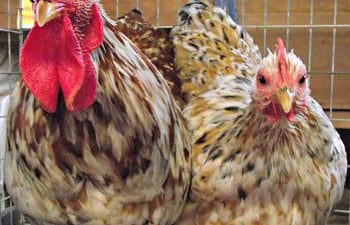Keeping a rooster can be fun and rewarding, and they are often great additions to the flock, and beautiful to boot. However, there is a lot of misinformation floating around about them, and several very persistent myths. So, what's true and what's just plain old misinformation?
Myth One: Roosters aren't chickens.
This one may sound silly, but it's a common misconception that hens are chickens and roosters are, well, roosters, and not chickens. Of course, people know that the hen and the rooster are the same species, but it is common to see people referring to hens as chickens instead of hens, and roosters as roosters. This is why you'll get people asking if their bird is a chicken or a rooster. Of course, it's a chicken either way, but what they really mean is, is my bird a hen or a rooster? Chicken is the name of the species, and a hen or pullet is the female and a cockerel, cock, or rooster is the male, just as with deer a male is a buck and the female is a doe, but of course both are still deer. So if you want to know if your bird is a male or a female, you want to know if it is a rooster or a hen. Either way, it is still a chicken.
Myth Two: All roosters will become aggressive to humans.
Anyone who has a good rooster knows that this isn't true, but you will often see people telling other people that as their cockerel matures, it will definitely become human aggressive and start attacking people. I would have to assume that's because they only have experience with aggressive roosters. I've had many roosters in my days as a chicken breeder, and only one has ever been aggressive, a hatchery stock Buff Orpington that showed up in my yard one day. The rest and there have been at least thirty, haven't ever so much as looked at me funny. Roosters are not guaranteed to grow up to be human attack birds, and in my experience with proper raising and stock selection, you rarely get a human aggressive rooster. Aggression can be genetic, so if it is all possible when getting a rooster make sure he comes from a non-aggressive father. If you have an aggressive rooster, don't let him breed as he can pass the trait to his sons. And if you have an aggressive rooster who is flogging you and making your life miserable, send him to the chopping block. There are too many nice roosters in need of good homes to put up with that behavior.
Myth Three: Two roosters can never live together and will kill each other.
Often I see people telling other people that if they have more than one cockerel in their batch of chicks, they're going to need to give one away because when they mature and their hormones kick in they will fight and one will kill the other. While there may be some scuffling to determine the pecking order, this isn't true either. Even hens fight to establish the pecking order, and cockerels that grow up together figure out the pecking order at the same time that their sisters do, as chicks, and when they reach adulthood they respect this and, in my experience, rarely fight. There will be some chasing to assert dominance, and the dominant rooster will often chase the lower males away from hens if they attempt to mate, but bloody all-out fights are rare, and never have I had a rooster kill another rooster. One always backs down before that point. This may not be true of game breeds, some of which were actually bred to fight, but most farm birds are not like this. Even when introducing a new rooster to a flock with an existing rooster that it has never before come into contact with and did not grow up with, after the initial fight to sort the new pecking order, there is almost never any fighting because the pecking order is respected. As long as you have enough hens, you can definitely keep more than one rooster in your flock.
Myth Four: A rooster is needed for a hen to lay eggs.
It is commonly believed that a hen needs a rooster present to stimulate her to lay eggs. Actually, a hen will lay eggs whether there is a rooster in the flock or not. Egg production has nothing to do with whether there is a rooster around. A hen can never see a rooster her whole life and will stay lay plenty of eggs.
Myth Five: The only reason to keep a rooster is if you want fertile eggs and chicks.
While it is true that the only reason it is absolutely necessary to keep a rooster is if you want fertile eggs and chicks from your own birds, it is far from the only reason! Roosters have many other purposes too. They will protect your hens from danger and will always be on the lookout to alert if they see a predator. They will find food for your hens and call them over so they can eat it. They will even give their lives for their hens, running to fight a predator while the hens run away to find safety and hide.
Myth Six: A rooster will crow only when the sun comes up.
While a rooster will crow when the sun comes up, that's not the only time he will crow. He'll crow all day long. The crow isn't to wake the flock up, it's to announce to everyone in the area that he is here and that this is his flock, and he is big and strong and will defend it, just as lions roar to say that they own their territory and will fight to keep it. So he'll crow in the morning, afternoon, evening, and even at night if something wakes him up in the coop. So if you're getting a rooster, don't expect to get one crow a day! Also, not just roosters will crow. If you have a flock without a rooster, the dominant hen may actually crow, so don't panic if that bird that has been laying you eggs suddenly crows, she's not turning into a rooster! It's uncommon, but it does happen.
Myth Seven: Roosters will attack chicks.
While some roosters will attack chicks, just as some hens will, this is also for the most part false. A rooster will usually protect chicks in a flock - chances are that they are his children, and it would be silly of him to kill them, as he wants to pass his genes on. I've never had a rooster attack chicks. Some silkie roosters have even been known to take in and care for orphaned chicks, and in Thai game fowl, it is not uncommon for the rooster to care for the chicks just like the hen does.
Myth Eight: Only roosters get spurs, and you can tell a chick is a rooster if it has spur bumps.
Actually, all chicks have spur bumps, even the pullets, and some hens will grow spurs. In the Sumatra breed, almost all hens have spurs, and sometimes they even have more than one spur on each leg! There is no way to tell the gender of a chick by whether it has spur bumps.
Myth Nine: A rooster always has a big comb and wattles.
While roosters usually have larger combs and wattles than hens, it all depends on comb type. We are used to seeing roosters with huge single combs, but there are different comb types, and, as you can see from the picture above, a rooster doesn't always have a huge comb and wattles - he can even have no wattles at all! Some roosters are even hen-feathered, in the case of Sebrights, and don't even have the long flowing hackle and saddle feathers that most people use to identify a rooster.
Myth Ten: Some breeds of roosters are quieter than others.
Unfortunately, no one breed of chicken is known to have quieter roosters than another. Of course, bantam roosters can't get quite the same volume going as a large fowl rooster can, but they are still loud. There is no breed known to crow less than another, and there is no way to tell if a rooster will be one that seldom crows or one that keeps you up all night by its breed. Each bird is an individual, and you just can't tell how loud or quiet or frequently a rooster will crow by its breed.
So there you have it, ten common myths about roosters debunked. Roosters are great additions to any flock and if your local laws allow one, there's no reason you shouldn't have one if you'd like one. I couldn't imagine my flock without any roosters. And in case you were wondering, there is a rooster in every picture in this article - yes, even the chick is a cockerel!

